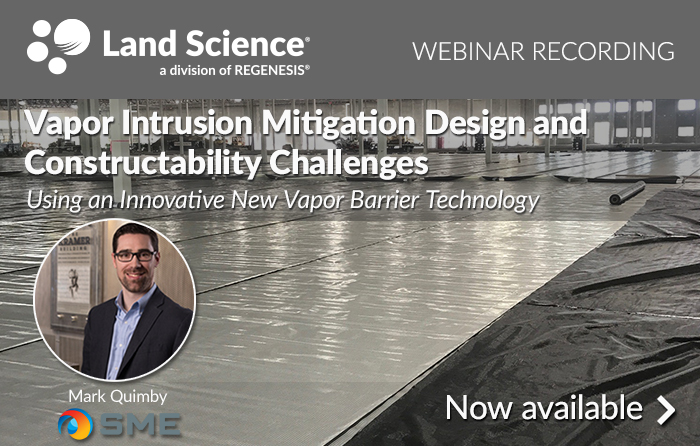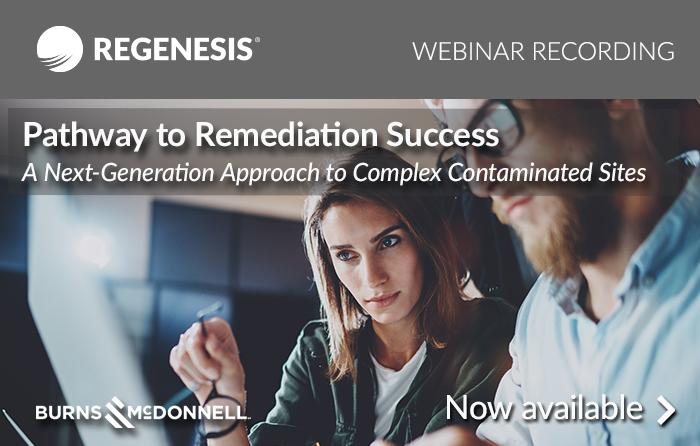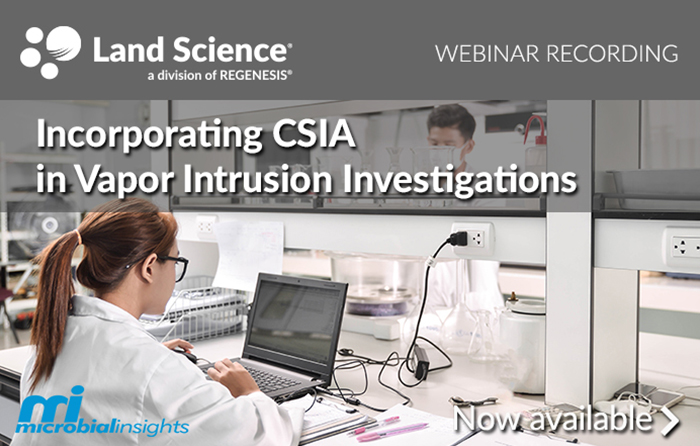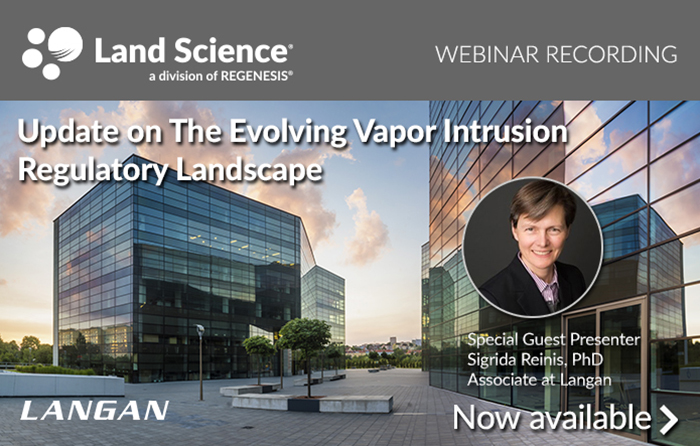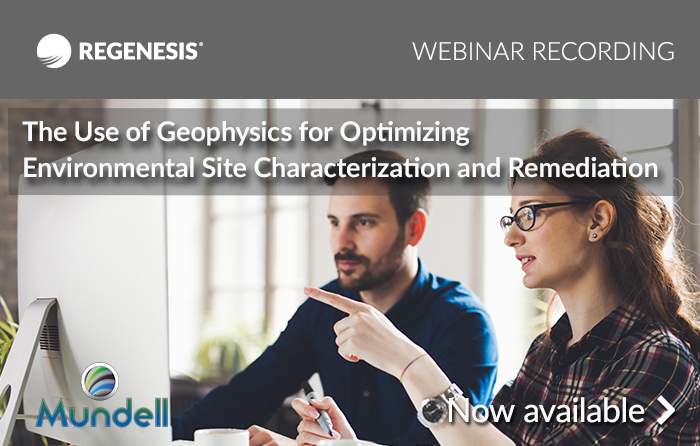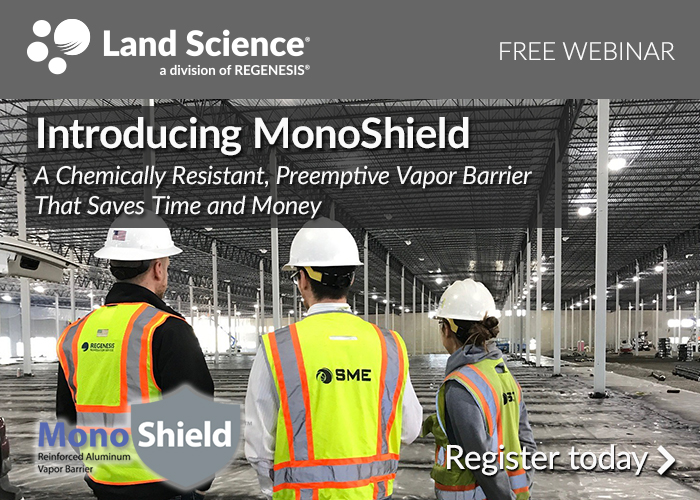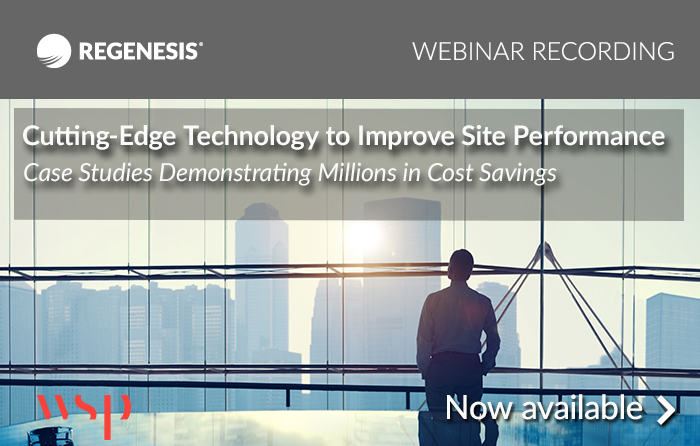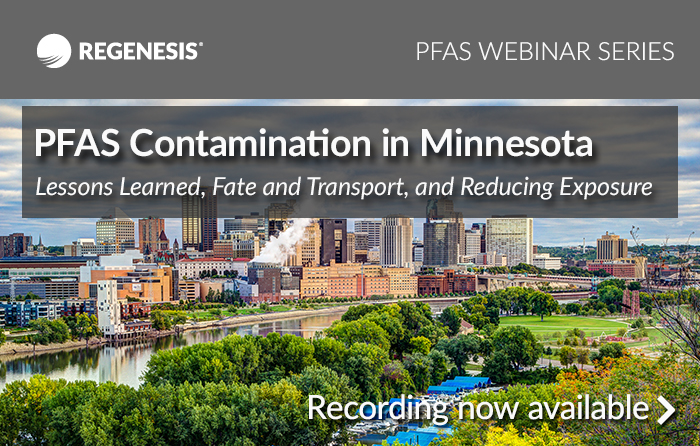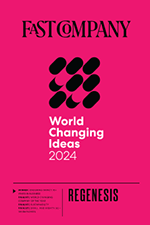Vapor Intrusion Mitigation Design And Constructability Challenges: Using An Innovative New Vapor Barrier Technology
Learn the following in this free webinar:
- Use of a reliable, cost-effective vapor mitigation solution allowed client to meet milestones and stay on time and on budget
- Sites required a vapor barrier that was resistant, with documented diffusion coefficients, to low level TCE and methane that could be approved by Michigan’s Department of Environment, Great Lakes & Energy (EGLE)
- Collaboration between EGLE, local community leaders and the developer ensured a smooth and successful result
- Traffic control program minimized barrier damage during construction and the enhanced smoke testing program successfully identified areas requiring repair
In this webinar we are pleased to have as a special guest speaker Mark Quimby, Senior Consultant at SME. His presentation discusses overcoming vapor intrusion mitigation design and constructability challenges at two large industrial sites using an innovative new vapor barrier technology. The sites discussed are new buildings approximately 575,000 square feet (SF) each, on two different, but similar, former landfill sites. He is joined by Ryan Miller, East Region Manager at Land Science, who discusses technologies to mitigate vapor intrusion.
View this free webinar
Six Pilot-Scale Studies Evaluating the In-Situ Treatment of PFAS in Groundwater
Highlights of this free webinar:
- The results from the adsorption-based permeable reactive zones (PRZ) indicated that attenuation of the PFAS was occurring.
- Colloidal activated carbon (CAC)-based PRZ showed the best performance with all the PFAS analyzed being removed to below their respective detection limits (10 ng/L).
- The powdered activated carbon (PAC)-based PRZ showed variable treatment.
- The biochar and ion exchange resins (IER) PRZs initially attenuated the PFAS but then had breakthrough of the C4 PFAS compounds prior to the 6-month post-injection sampling event, with the remainder of the PFAS compounds breaking through prior to the 9-month post injection sampling event.
In this webinar we were pleased to have as a special guest speaker Rick McGregor, President of InSitu Remediation Services Ltd. His presentation discussed six pilot-scale studies evaluating the in-situ treatment of PFAS in groundwater. PFAS are an emerging suite of compounds that have gathered wide-spread attention but have few remedial options. Research and limited field studies suggest that some reagents have promise for the removal of PFAS from groundwater. Six reagents were chosen for pilot testing including hydrogen peroxide, unactivated sodium persulfate, CAC, PAC, biochar and IER to determine if the reagents could be effective at reducing/removing the PFAS. Various PFAS were detected within the pre-treatment groundwater including PFDS, PFBA, PFPeA, PFHxA, PFHpA, PFOA, PFOS and PFNA with concentrations ranging up to 18,000 ng/L for PFPeA. Six pilot-scale permeable reactive zones (PRZs) were created in a shallow, unconfined aquifer situated in a slightly saline, sulfate-iron reducing environment. The groundwater was also impacted with gasoline-range petroleum hydrocarbons along with various additives including MTBE and TBA.
View this free webinar
Pathway to Remediation Success: A Next-Generation Approach to Complex Contaminated Sites
In this webinar we are pleased to have as special guest speakers John Hesemann, Remediation Technical Practice Leader, and Rick Cramer, Environmental Sequence Stratigraphy Practice Leader of Burns & McDonnell. Their presentation discusses the next generation approach to tackling remediation of complex contaminated sites. They are joined by Craig Sandefur, Vice President of Technical Services at REGENESIS, who discusses Design Verification Testing (DVT) activities to improve performance results and reduce project costs at contaminated sites.
Highlights of this free webinar:
- Learn how a focus on Remediation Geology defines the “static” subsurface framework that is the primary control on subsurface fluid dynamics.
- And how this, combined with improved understanding of subsurface processes, results in a Process-Based CSM that informs all stages of the remediation life cycle.
- Case studies presented will show how this approach applies to all complex sites, regardless of location, contaminant, and subsurface conditions.
View the recording of this free webinar
About the Presenters
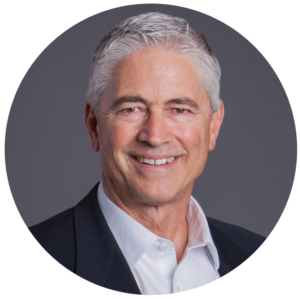 Rick Cramer, PG
Rick Cramer, PG
CA Remediation Department Manager, Burns & McDonnell
Rick Cramer is a California licensed Professional Geologist (PG) with over 30 years of environmental experience, and serves as the Remediation Department Manager and Environmental Sequence Stratigraphy Practice Lead with Burns & McDonnell out of their Brea, California office. Rick has a BS degree in geology from University of the Pacific and a MS degree in geology from University of California, Davis. He began his professional career in the petroleum industry, and pioneered the application of sequence stratigraphy to groundwater projects.
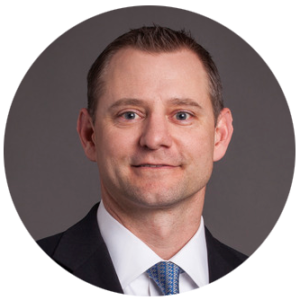 John Hesemann, PE
John Hesemann, PE
Remediation Technical Practice Leader, Burns & McDonnell
John is a Licensed Professional Engineer (PE) with over 21 years of environmental experience, and serves as Burns & McDonnell’s Remediation Technical Practice Leader for Environmental Division. John earned B.S. and M.S. degrees in Geological Engineering from the Missouri University of Science and Technology and is a licensed professional engineer in the states of Connecticut, Illinois, Kansas, Louisiana, Massachusetts, Missouri, and Oklahoma. He has personally led or supported over 100 remediation projects in 17 states, mostly for industrial clients managing risks associated with chlorinated solvents, petroleum compounds, and other recalcitrant contaminants. As Burns & McDonnell’s Remediation Technical Practice Leader, John leads groups of remediation professionals and practitioners dedicated to developing and implementing effective solutions for private and public sector clients.
 Craig Sandefur
Craig Sandefur
Vice President of Remedial Applications Development, REGENESIS
Craig Sandefur is the Vice President of Remedial Applications Development at REGENESIS and a recognized expert with over 20 years of experience in the areas of in situ remedial design and applications. In his current role at REGENESIS, Mr. Sandefur is part of team of geologists located throughout the United States that provide remediation designs and optimize performance for REGENESIS clients. Under his direction, the Technical Services team at REGENESIS developed a Design Verification Testing (DVT) program, which consists of a suite of field sampling and testing activities carried out prior to subsurface remedial reagent emplacement. The DVT program at REGENESIS has also pioneered the use of Passive Flux Meters (PFM) in conjunction with contaminant plume aspect ratio analysis. This program has directly informed REGENESIS design and application teams, resulting in significant improvements in remedial reagent emplacement, project remedial outcomes and project cost reductions.
Case Study: Petroleum Contaminants from UST at Non-Detect within 60 Days using PetroFix
In this webinar we are pleased to have as a special guest speaker Gordon Dean, Vice President of Advanced Environmental Technologies, LLC (AET). His presentation discusses a multi-use convenience store site in Panama City Beach, Florida impacted by contamination from a leaking underground storage tank (UST), where PetroFix® Remediation Fluid, a micro-scale carbon suspension with soluble electron acceptors, was applied to reach target goals within 60 days. He is joined by Chad Northington, Southeast District Manager at REGENESIS, and Todd Herrington, Global PetroFix Product Manager at REGENESIS.
Highlights featured in this webinar:
- AET treated high concentration source areas by provding a permanent, in situ sorptive and biologically permeable reactive barrier (PRB) at a UST site
- A cost analysis was conducted to identify a remediation technology that was affordable and would be guaranteed to lower the contaminant levels below the target levels
- PetroFix Remediation Fluid can be applied under low pressure to capture and biodegradate petroleum contaminants
View the recording of this free webinar
Incorporating CSIA in Vapor Intrusion Investigations
Land Science is pleased to present a webinar with Dora Taggart, President of Microbial Insights, Inc., and Sam Rosolina, PhD, Analytical Chemist and Manager of the Compound Specific Isotope Analysis (CSIA) Laboratory at Microbial Insights. In this webinar, Dora and Sam discuss incorporating CSIA in vapor intrusion investigations. They are joined by Tom Szocinski, CEP, Director of Vapor Intrusion at Land Science, who discusses innovative new vapor barrier technologies that are more protective and more cost-effective.
Learn the following in this free webinar:
- A primer for sites impacted with contaminant vapor intrusion
- How CSIA is being used to fingerprint different contaminant sources
- Using CSIA to help identify the underlying cause of decreased indoor air quality
Many of the contaminants commonly impacting indoor air through vapor intrusion can also be found in a number of house-hold items and products. Are the chlorinated solvents detected in the air originating from the groundwater beneath the building, or is a bottle of adhesive the actual source? Is the benzene detected in the basement a direct result of an upgradient petroleum release, or from the cigarette of the construction worker in the next room? Determining the source of impact is an important first step in investigating vapor intrusion cases and can save time and money in the long run. This webinar serves as a primer for vapor intrusion, and highlights how compound specific isotope analysis is being used to fingerprint different contaminant sources and help to identify the underlying cause of decreased indoor air quality. With the added context of Microbial Insights’ new CSIA database, the results are automatically plotted for you, making it easy to visualize and interpret the data.
FAQ: CSIA and Vapor Intrusion
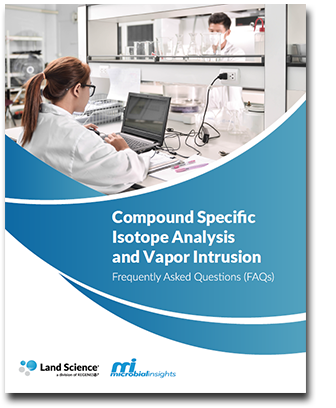 The questions summarized in this FAQ as part of the Land Science “Distinguished Speaker” webinar series, were provided by our guest presenters, Dora Taggart and Sam Rosolina, PhD in response to questions fielded throughout the webinar presentation. REGENESIS and Land Science are grateful to both Ms. Taggart and Dr. Rosolina for sharing their expertise. Land Science is dedicated to providing relevant, industry-leading content in support of client partners globally. Any use or reproduction of the contents of this FAQ document must be approved by Land Science, REGENESIS and/or Microbial Insights.
The questions summarized in this FAQ as part of the Land Science “Distinguished Speaker” webinar series, were provided by our guest presenters, Dora Taggart and Sam Rosolina, PhD in response to questions fielded throughout the webinar presentation. REGENESIS and Land Science are grateful to both Ms. Taggart and Dr. Rosolina for sharing their expertise. Land Science is dedicated to providing relevant, industry-leading content in support of client partners globally. Any use or reproduction of the contents of this FAQ document must be approved by Land Science, REGENESIS and/or Microbial Insights.
Want to learn more about CSIA and Vapor Intrusion? Download the Q&A from the webinar here:
View the recording of this free webinar
Update on The Evolving Vapor Intrusion Regulatory Landscape
Land Science is pleased to present a webinar with vapor intrusion expert Sigrida Reinis, PhD, PE, Associate at Langan. During this webinar presentation, Dr. Reinis discusses the increasingly challenging vapor intrusion regulatory landscape, and solutions to address vapor intrusion challenges at sites. Rick Gillespie, REGENESIS and Land Science Senior Vice President, North America also presents innovative new vapor barrier technologies that are more protective and more cost-effective.
Learn the following in this free webinar
- Changing trends in the vapor intrusion regulatory landscape at the federal and state levels
- How to meet the demands of increasingly data-driven regulations
- Case studies of vapor intrusion sites where extensive data-driven challenges were addressed
View this free webinar
The Use of Geophysics for Optimizing Environmental Site Characterization and Remediation
In this webinar we are pleased to have as special guest speakers John A. Mundell, P.E., L.P.G., P.G. and Ryan Brumbaugh, L.P.G. of Mundell & Associates, Inc. This Webinar discusses the use of geophysical survey applications to enhance standard environmental site characterization practices and improve the design of remedial alternatives for complex site and geologic conditions. A summary of the use of various geophysical methods applied to environmental projects is provided, focusing on such methods as electromagnetic metal detection, electromagnetic conductivity, two-dimensional electrical resistivity, ground penetrating radar (GPR), seismic, microgravity and downhole logging.
This presentation includes selected case histories demonstrating the successful application of geophysical surveys for:
- Environmental Site Assessments
- Industrial Contamination Projects
- Groundwater Investigations and Remediation
FAQ: Use of Geophysics for Optimizing Remediation and Site Characterization
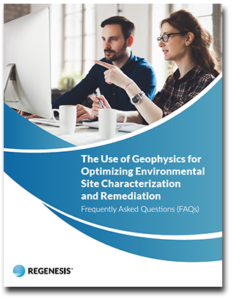 This Q&A is a result of the questions posed during the presentation from Mundell & Associates and REGENESIS. The questions summarized as part of the REGENESIS “Distinguished Speaker” webinar series were provided by our guest presenters, John A. Mundell and Ryan Brumbaugh in response to questions fielded throughout the webinar presentation. REGENESIS is grateful to both Mr. Mundell and Mr. Brumbaugh for sharing their expertise. REGENESIS is dedicated to providing relevant, industry-leading content in support of client partners globally. Any use or reproduction of the contents of this FAQ document must be approved by REGENESIS and/or Mundell & Associates.
This Q&A is a result of the questions posed during the presentation from Mundell & Associates and REGENESIS. The questions summarized as part of the REGENESIS “Distinguished Speaker” webinar series were provided by our guest presenters, John A. Mundell and Ryan Brumbaugh in response to questions fielded throughout the webinar presentation. REGENESIS is grateful to both Mr. Mundell and Mr. Brumbaugh for sharing their expertise. REGENESIS is dedicated to providing relevant, industry-leading content in support of client partners globally. Any use or reproduction of the contents of this FAQ document must be approved by REGENESIS and/or Mundell & Associates.
Want to learn more about geophysics? Download the Q&A from the webinar here:
View this free webinar
Introducing MonoShield: A Chemically Resistant, Preemptive Vapor Barrier That Saves Time and Money
Land Science, a division of REGENESIS, is pleased to present a webinar with vapor intrusion expert Tom Szocinksi, CEP and Dr. Kristen Thoreson, Research and Development Director at REGENESIS and Land Science. During this webinar presentation, they discuss an innovative new vapor intrusion barrier technology called MonoShield. A chemically resistant and easy-to-apply barrier, MonoShield is specifically designed as a preemptive solution for vapor intrusion at brownfield redevelopment sites.
Learn the following about the new technology MonoShield in this free webinar:
- MonoShield can be installed 30-40% faster than alternate plastic sheeting or HDPE systems.
- MonoShield offers superior durability and chemical resistance.
- Competitively priced with simple quick installation
View this free webinar
Cutting-Edge Technology to Improve Site Performance: Case Studies Demonstrating Millions in Cost Savings
In this webinar we are pleased to have as a special guest speaker Matt Burns, Technical Fellow and the U.S. Contaminated Land National Service Line Director for WSP. In this webinar he discusses project case studies where in situ remediation was chosen as an alternative compared to conventional liability management strategies due to significant cost-savings. Matt Burns is joined by Maureen Dooley, Director of Strategic Projects at REGENESIS. Actionable molecular biological tools (MBT) data collection strategies and life-cycle cost comparisons between conventional and in situ technologies are presented for 2 sites.
Sites discussed include:
- A site with a large, oxic, dilute TCE plume with no apparent degradation products present. At this site, both cometabolic oxidation and abiotic reduction were assessed using qPCR, CSIA and magnetic susceptibility. Additionally, carbon-14 TCE assays were performed ex situ to quantify degradation rates along both pathways. Resultant degradation rate data was used to construct a four-dimensional reactive fate and transport model.
- A large chlorinated VOC plume in fractured sandstone where back diffusion is a confounding factor. At this site, a PlumeStop® plus bioremediation combined remedy pilot test was assessed using aquifer matrix in situ microcosms, deployed before amendment application, combined with qPCR and CSIA. The microcosm construct overcomes the sample collection constraints associated with analyte partitioning from the aqueous phase and allowed for the direct assessment of degradation occurring on the PlumeStop® activated carbon particle.
View this free webinar
PFAS Contamination in Minnesota: Lessons Learned, Fate and Transport, and Reducing Exposure
In this webinar we are pleased to have a special guest presentation by Virginia (Ginny) Yingling, Senior Hydrogeologist in the Environmental Health Division of the Minnesota Department of Health. Ginny discusses PFAS contamination in Minnesota, including lessons learned from the state’s investigation of a chemical production facility, contaminant fate and transport, and reducing exposure. She is joined by Kristen Thoreson, PhD, Director of Research and Development at REGENESIS.
Learn the following in this free webinar:
- State of Minnesota’s investigation of an area of PFAS-contaminated groundwater that covers over 150 sq. miles
- Challenges faced by Minnesota Department of Health in communicating the risk of PFAS to the public
- Lessons learned, key aspects of unique PFAS fate & transport behavior observed, and successes in reducing exposures
- How to eliminate risk of PFAS via low-cost in situ remediation using colloidal activated carbon

 Americas
Americas Europe
Europe Français
Français Deutsch
Deutsch Italiano
Italiano Español
Español